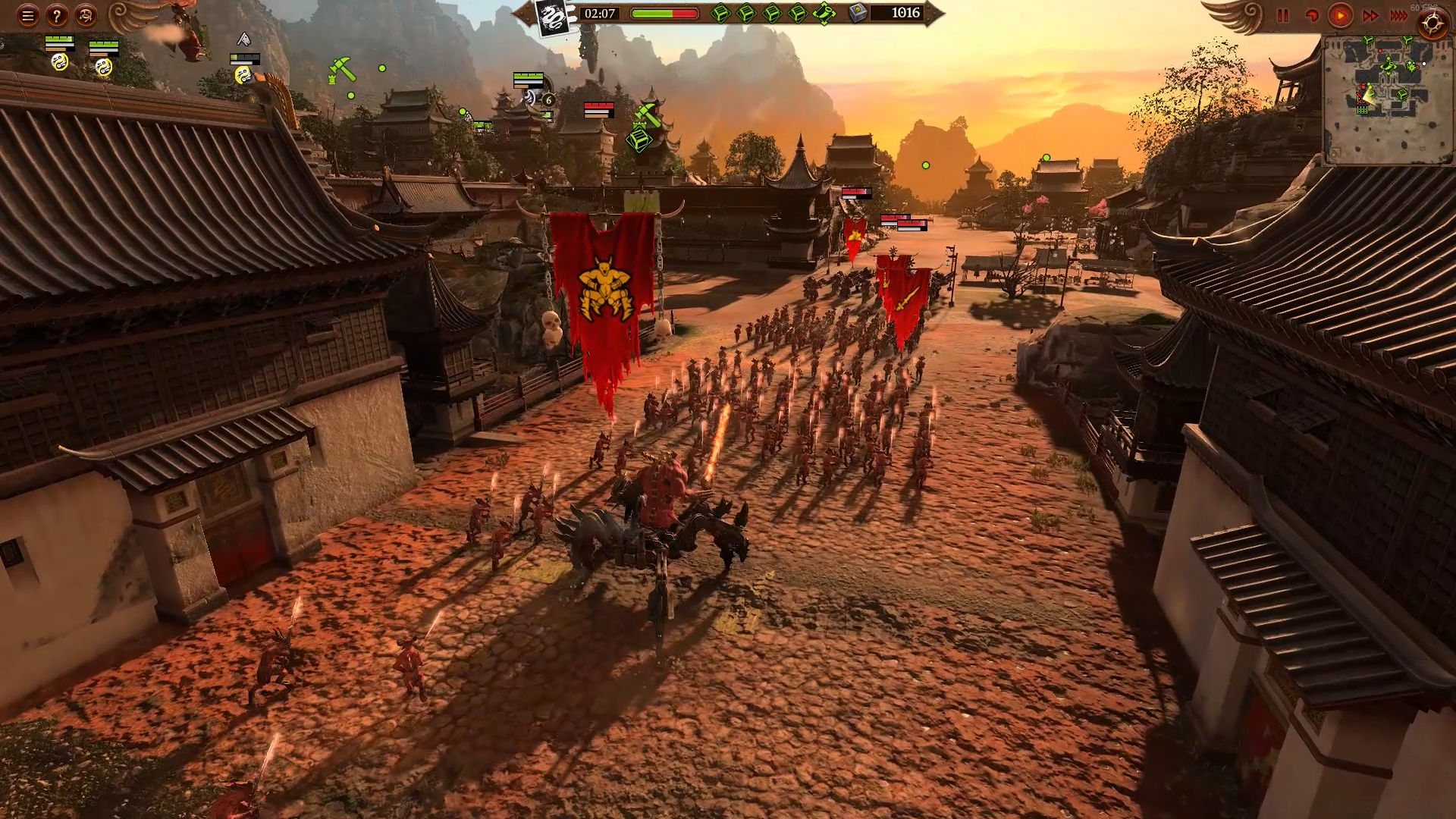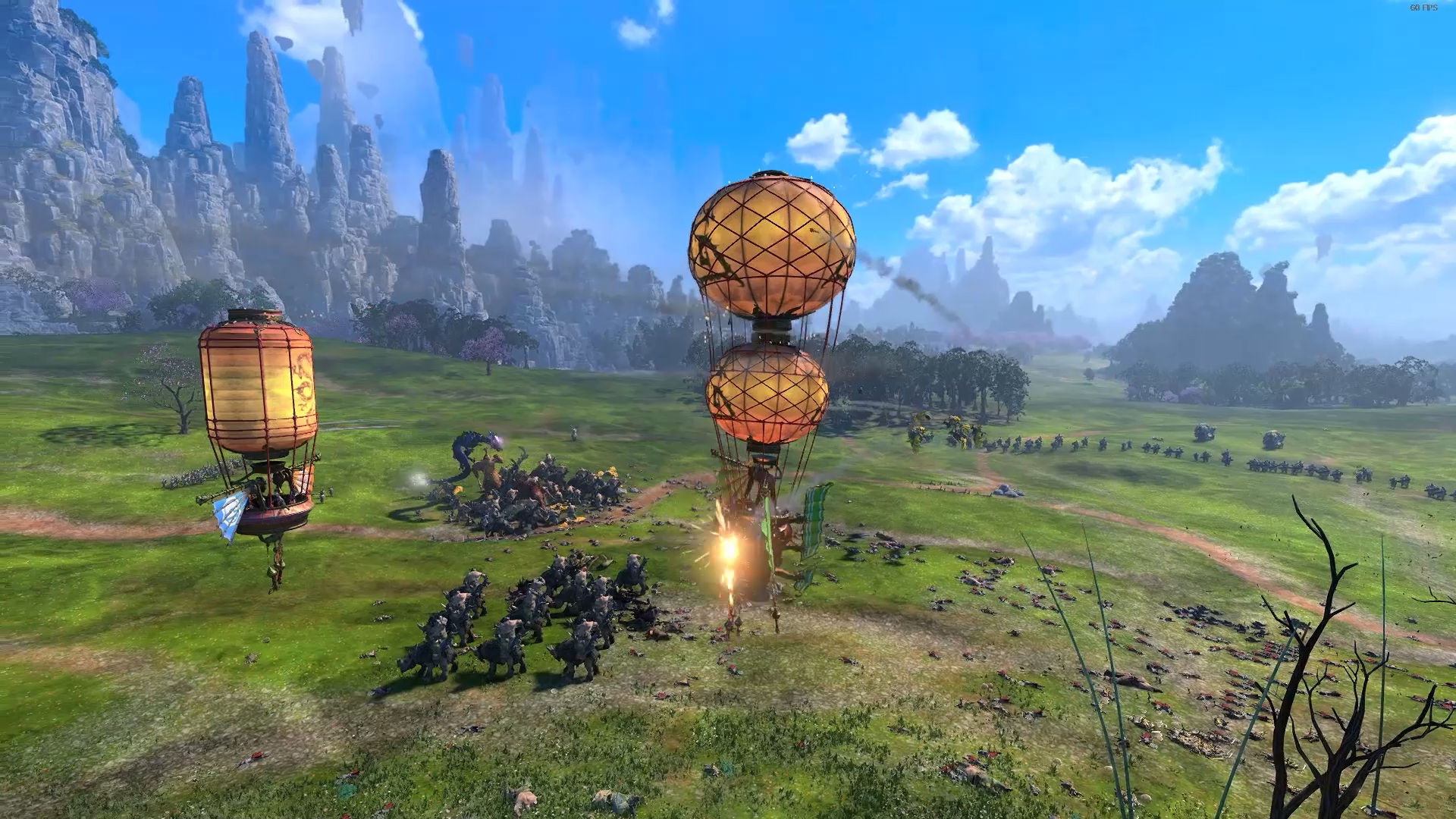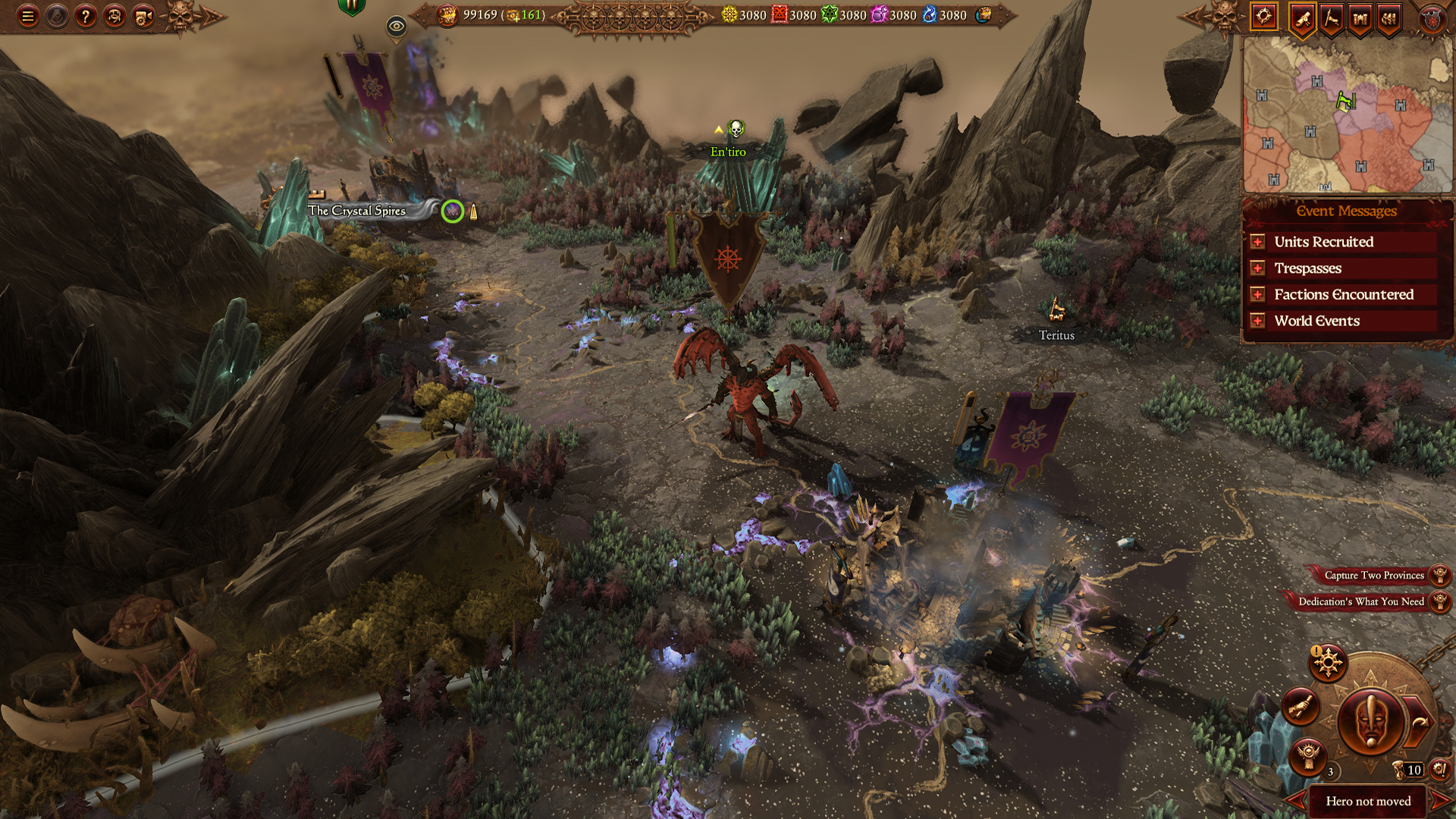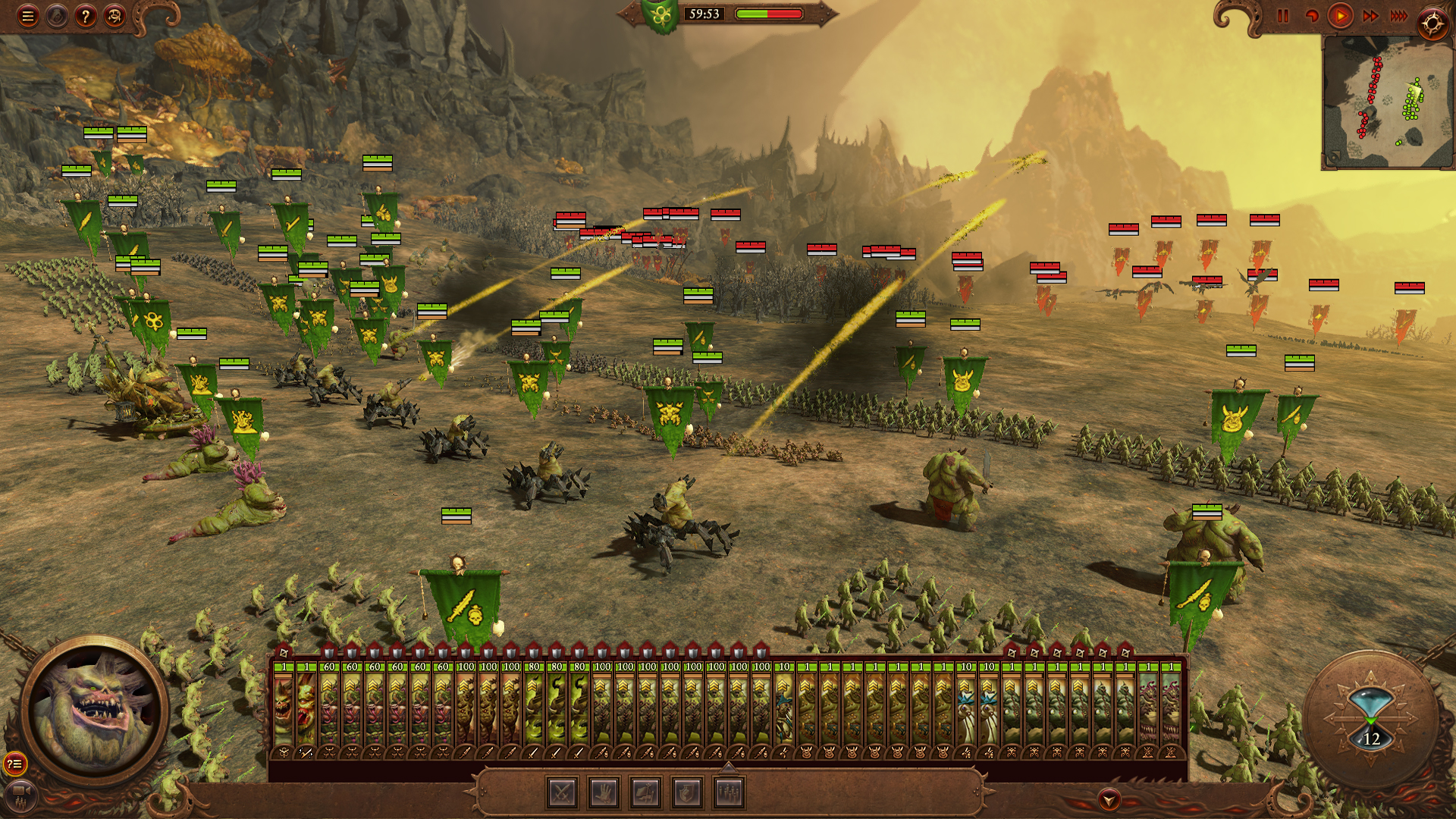Time played: 30 hours
Platform: PC
The fortress of Tzeentch is within sight. Our army has taken a beating from the Chaos God’s mutant fiends, and his twisted realm isn’t doing us any favors. It’s a fractured world of floating islands and arcane monoliths, all connected by a series of teleportation stones that will randomly transport my force somewhere across the map. If we can navigate the web of relays, we’ll make it to the stronghold for a final showdown with Tzeentch’s champion. If we can keep our army standing, we might just stand a chance.
Throw in the swarms of cultists, horrors, and chariots chasing me across the campaign map, as well as the odd rival faction looking to muscle in on our march forward, and this tour across the Realm of Chaos is no walk in the park. It’s a frantic dungeon crawl; a race against time that embraces all the fantastical absurdities of Warhammer in a cataclysmic set piece.
None of this is typical of a Total War game. What started as a historical sandbox strategy series touched on fantasy for the first time with 2016’s Total War: Warhammer. That was a fairly restrained take on the grimdark universe, and was soon overtaken by its sequel, which ditched any semblance of grounded realism in favor of wackier factions and inflated design. Everything was bigger, everything was more extreme, and the wildly weird was set loose to amazing effect. That trend towards absurdity is now complete with this third installment.
Total War: Warhammer 3 is one of the most spirited and cinematic strategy games we’ve ever played. Where previous entries in the Total War series – both historical and Warhammer titles – tried to go bigger through introducing larger maps, more factions, and additional mechanics, Warhammer 3 takes a different approach. Within its sprawling sandbox is a framed and focused narrative that not only shapes the pacing of the core campaign, but sets up its most exciting moments.
Total War: Warhammer 3 release date and price
- What is it? A fantasy strategy game and the third installment in the Total War: Warhammer series
- Release date? February 17, 2022
- What can I play it on? PC
- Price? $59.99 / £49.99 / $AU89.95
Chaotic variety

Warhammer 3’s topline pitch is simple: you get to play as Chaos, the big bads of the Warhammer world. Between the plague god Nurgle, the bloodthirsty Khorne, the debaucherous Slaanesh, and sorcerous Tzeentch, you’re handed an impressive collection of corrupted villainy to spread across the map. Each army feels distinct and more varied than half the historical sword-and-spear factions of previous Total War games. The melee-focused forces of Slaanesh are adept at hit-and-run tactics, Nurgle’s children crush opponents under swarms of putrid Nurglings and gigantic monsters, Khorne specializes in elite soldiers, while Tzeentch excels at ranged attacks and magic abilities.
Besides the tactical variety at play here, the sheer visual assortment of daemons is enough to give each faction its own personality. In one battle, you might be fielding flaming hellhounds alongside monstrous beasts with names like Soul Grinder. In the next, you could be tearing your way through the putrid flesh of Plague Toads and gigantic flying mosquitoes. This is Total War: Warhammer at its most colorful. Creative Assembly wasn’t afraid to embrace the strangest, most surreal, and often silliest elements of the Warhammer universe to create a strategy game that’s remarkably broad in its visuals.
"Creative Assembly hasn't been afraid to embrace the strangest, most surreal, and often silliest elements of the Warhammer universe."
That variety plays out on the grand campaign, too. You’ll be following the usual Total War formula of recruiting armies, conquering cities, and bunkering down behind your walls to stave off invading forces, before returning to the offensive. Little has changed from the core gameplay loop of Warhammer 2, but the specialties of each faction keep things fresh. Khorne’s bloodletting ability strengthens your armies after every battle, as well as letting you raise reinforcements by razing settlements, encouraging you to constantly keep up the momentum behind your offensive. Nurgle, meanwhile, is better suited to more invasions, as you wait for plagues to afflict your enemies and your cyclical settlements to decay and rot, before rising again.
That’s to say nothing of the game’s other factions. With Kislev, Cathay, the Daemons of Chaos, and the Ogre Kingdoms (for those who pre-order the game or buy it in its first week of launch) available, Warhammer 3 has the chunkiest launch faction line-up of all the Total War: Warhammer games. Those who want a run-of-the-mill human army to command can stick with Kislev. If you’re after the most extreme Warhammer 3 experience, pick the Deamons of Chaos, an amalgamation faction that mashes together all the Chaos armies together into one big melting pot, while introducing its own faction mechanics on top.
Bear fight

While narrative takes a bigger role in the game, you don’t need to be a Warhammer aficionado to follow along. The game’s excellent prologue introduces its core gameplay concepts and story across a three-hour mini-campaign. There’s a trapped God-bear under the imprisonment of a Daemon Prince, a traitorous hero who’s corrupted by Chaos, and a wizened old man desperate to reach the bear for his own wicked schemes.
What’s more exciting is how this narrative shapes the grand campaign. Much like Total War: Warhammer 2’s vortex campaign, territorial domination is out. Instead, you’ll be skirmishing across the map, waiting for portals to the Realm of Chaos to appear every 30 turns or so. Each rift leads into the domain of one of the four Chaos Gods. Take an army through, and they’ll be transported to a new, small area that’s entirely disconnected from the main campaign map.
"As we progressed, less of our efforts were spent conquering neighboring lands, and more time was spent shoring up our forces, readying them to enter the Chaos rifts."
These domains operate like standalone dungeons. For each, you’ll have to fight your way through the minions of that domain’s Chaos God, secure an artifact, and make your way to the final stronghold for a climactic battle against their toughest units. All the while, enemy factions are trying to beat you to the punch, creating a frantic race to the finish line. Each Chaos domain has novelty – whether that’s Nurgle’s infectious miasma that will constantly damage your troops, or Tzeentch’s floating labyrinth that you’ll have to stumble through – to prevent them feeling too repetitive. That’s handy, because you’ll need to do this four times (once per Chaos God) to unlock Warhammer 3’s endgame.
Although these encounters play out as discrete episodes, they’re strongly intertwined with the overall campaign. You can’t just go bounding into one of these dungeons expecting victory to land in your lap; you’ll need to rigorously prepare beforehand. They dramatically impacted how we approached the campaign, sucking up much of our resources and attention. As we progressed, less of our efforts were spent conquering neighboring lands, and more time was spent shoring up our forces, readying them to enter these Chaos rifts. The result is that each rift feels cinematic and significant, punctuating the wider campaign on which the progress and fortunes of your burgeoning empire depend.
Sprawling direction

For the most part, this plays out wonderfully. Campaigns constantly build in momentum as you ready your forces to enter the rifts. There’s no room for aimless conquering or tedious meandering around the map; your progress is firmly, but not linearly, directed forward. Even when you’ve cemented your military dominance, and could largely have considered yourself to have all but won in previous Total War games, the rifts give you a larger objective to fight for, keeping the pace high.
At moments, though, this forced direction can be frustrating. During one of our campaigns, the portals appeared when we were halfway through carving up an enemy faction, throwing a spanner in the works of our carefully laid plans. Having to react to those unexpected gateways, which began spewing Chaos armies across our lands, was pretty exciting. But less exciting was the tedium it involved. Flitting back and forth between the main-world map and the Chaos domains became a nuisance. Both fronts demanded our attention, but we often found ourselves focusing on one at the expense of the other, uninterested in what was happening on the main map when we were leading an army through the more exciting Realm of Chaos.
Of course, you can ignore all of that. While entering the rifts to defeat the four Chaos champions is the ‘proper’ way of playing the game, victory through classic territorial domination is possible. For that win condition, you’ll need to defeat specific factions and control a certain number of regions. But while that might appeal to fans of older Total War titles, it’s certainly not the way Warhammer 3 is meant to be played. The rifts are central to the grand campaign’s pacing and variety. You’re better off settling for Warhammer 2 or one of the historical Total War titles if you’re more interested in painting a map with your faction colors.
Emergent gameplay

Where Warhammer 3 really excels is in presenting the many options available to you, but requiring that you pay close attention to none of them. You can happily steamroll into a war without any idea of a plan, let alone a semblance of strategy, and still find yourself using the breadth of your faction’s abilities. It might not be the most efficient way of conquering, and is unlikely to make for a clean victory when facing the tougher armies at the end of the game, but Warhammer 3 makes even the most half-hearted conflicts enjoyable by handing you an array of strategic opportunities that are both straightforward and incredibly malleable.
Playing as a devotee of Slaanesh, our preferred choice of chaotic revelry, you’re endowed with the power to weaken enemies through seduction. As you conquer, you’ll gain Devotees (a kind of currency) to spend on powerful abilities that can turn the tide of a campaign. About to fight a particularly unfair battle? Seduce a few enemy units to join your side of the fight. Need some extra daemonic power to break an enemy siege? Raise a temporary army of Disciples to lend a hand. In one instance, we were able to start our invasion of a nearby faction of Khorne by using Slaanesh’s Seductive Influence to instantly vassalize a whole city, leaving us to wander off other offensive escapades while our vassal bore the brunt of the war effort.
At another time, our successive attempts to capture a particularly defiant city hadn’t gone to plan, but the constant assaults had spread Slaanesh’s influence to within its walls. Building a Chaos Cult within the enemy city, we could spread our corruption further, seeding the ground for a rebellion that would eventually open the door to a full invasion.
"Warhammer 3 might not reach the lofty heights of emergent storytelling that Crusader Kings 3 achieves through its RPG, character-focused gameplay, but it certainly moves in that direction."
These features, and the many others like them, let you expand your empire in ways other than by simply bashing massive armies together until one falls over. But besides adding plenty of variety, what impressed us most about Warhammer 3 was how it gives you these opportunities spontaneously, letting you find more ways to conquer than you ever considered. There’s no need to micromanage every metric of your empire. Instead, you might suddenly find that a neighboring faction has succumbed to your Chaotic corruption without any deliberate effort on your part. Or, less fortunately, discover that a rival Chaos Cult has cemented itself in your capital, leaving you with another threat to deal with.

Warhammer 3 might not reach the lofty heights of emergent storytelling that Crusader Kings 3 achieves through its RPG, character-focused gameplay, but it certainly moves in that direction. Set yourself an ambitious goal to strive towards if you want, but don’t be surprised if unexpected events drive you down a totally new, and usually more exciting, avenue.
Unfortunately, this does highlight just how underdeveloped diplomacy remains. While no Total War game has particularly fleshed out the non-aggressive ways of extending your empire, the diplomatic features fall even flatter in the Warhammer universe that’s centered on constant war. Most diplomatic stand-offs come down to a matter of cost, making them more of an economic consideration than a truly diplomatic one. If you have enough money in your coffers, you’ll be able to pay your way through anything. If you don’t, it’s best to not even bother, and instead agree to any ceasefire or trade alliance that happens to come your way.
Verdict
Total War: Warhammer 3 smoothly surpasses its predecessors. Creative Assembly’s bid to expand on the firm foundations of Warhammer 1 and 2 hasn’t just taken the series to new heights, but pushed it in a different direction. By framing Total War’s sprawling sandbox within a focused, narratively-charged campaign, Warhammer 3 is better-paced and more cinematic. All the best elements of the series are there –colorful fantasy factions, varied tactical opportunities, and a world-shattering scale – only this time, they’re even more enjoyable.
from TechRadar - All the latest technology news https://ift.tt/RYhzDBn

No comments:
Post a Comment